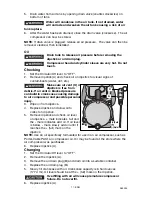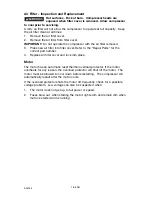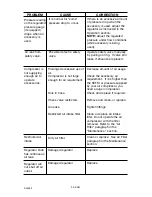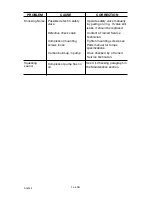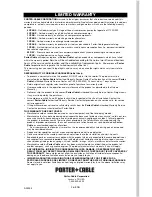
17- ENG
A02233
5.
Drain water from air tank by opening drain valve (counter-clockwise) on
bottom of tank.
Water will condense in the air tank. If not drained, water
will corrode and weaken the air tank causing a risk of air
tank rupture.
6.
After the water has been drained, close the drain valve (clockwise). The air
compressor can now be stored.
NOTE
: If drain valve is plugged, release all air pressure. The valve can then be
removed, cleaned, then reinstalled.
Oil
Drain tank to release air pressure before removing the
dipstick or oil drain plug.
Compressor head and cylinder sleeve are very hot. Do not
touch.
Checking
1.
Set the On/Auto/Off lever to “OFF”.
2.
Remove dipstick (A) and check oil on dipstick for visual signs of
contaminants (water, dirt, etc).
Make sure air vent (C) in
dipstick is free from
debris. If air vent is blocked pressure
can build in crankcase causing damage
to air compressor and possible personal
injury.
3.
Wipe oil from dipstick.
4.
Replace dipstick and allow oil to
collect on dipstick.
5.
Remove dipstick and check oil level
on dipstick, + mark indicates full and
the - mark indicates add oil. If oil level
is below - mark, slowly add oil until it
reaches the + (full) mark on the
dipstick.
NOTE:
Use an oil specifically formulated for use in an air compressor, such as
Porter-Cable PAS1 air compressor oil. Oil may be found at the store where the
air compressor was purchased.
6.
Replace dipstick (A).
Changing
1.
Set the On/Auto/Off lever to “OFF”.
2.
Remove the dipstick (A).
3.
Remove the oil drain plug (B) and drain oil into a suitable container.
4.
Replace the oil drain plug (B).
5.
Slowly fill crankcase with oil. Crankcase capacity is 6 fluid ounces
(177.4 ml). Oil level should be at the + (full) mark on the dipstick.
Overfilling with oil will cause premature compressor
failure. Do not overfill.
6.
Replace dipstick (A).
+
-
A
C
B
(+)Full
(-)Add
Summary of Contents for C2550
Page 25: ...25 ENG A02233 NOTES...















